Austria is home to a unique and diverse array of avian species, with over 300 species of birds inhabiting the country’s many mountains, valleys, lakes, and forests.
From the majestic Golden Eagle, to the colorful Great Spotted Woodpecker, Austria’s native birds offer a stunning spectacle of nature to behold.
With a variety of habitats ranging from high alpine peaks to the lowlands of the Danube, Austria’s avian population is both numerous and varied.
We will explore some of the most notable birds that call Austria home and explore their habits, habitats, and conservation status.
1. European Green Woodpecker
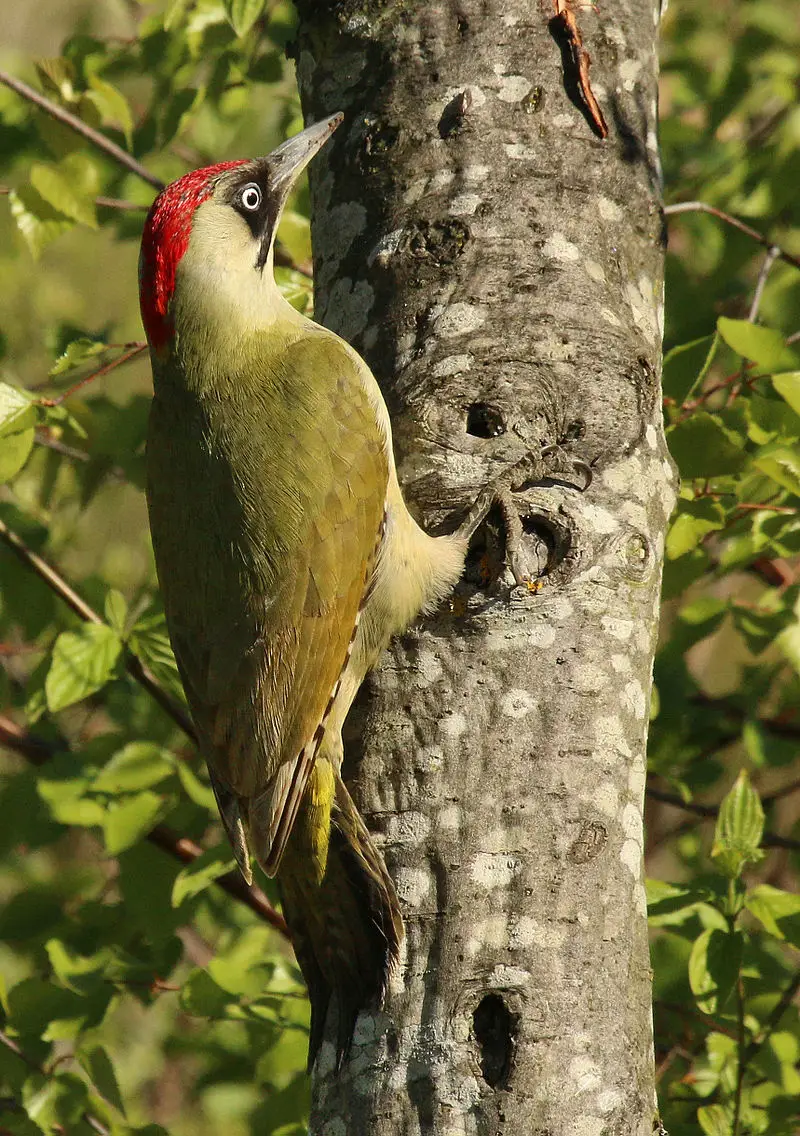
The European green woodpecker is a vibrant species with striking features. The body has an emerald hue, while males have a red crown and black moustache that extends to the middle of their forehead.
Females lack this characteristic feature but instead possess barred markings beneath the wings as well as yellow throats and cheeks.
It can be found in many parts of Europe and western Palearctic regions such as Spain and Portugal where it is replaced by its similar cousin; Iberian green woodpecker (Picus sharpei).
This bird loves inhabiting open forests or grasslands for its food source which typically consists on insects like ants, beetles, spiders among others.
Its powerful bill allows it to dig into tree bark searching for larvae underneath making it an efficient predator in these environments.Scientific classification:
| Kingdom | Animalia |
| Phylum | Chordata |
| Class | Aves |
| Order | Piciformes |
| Family | Picidae |
| Genus | Picus |
| Species | P. viridis |
2. Black Woodpecker
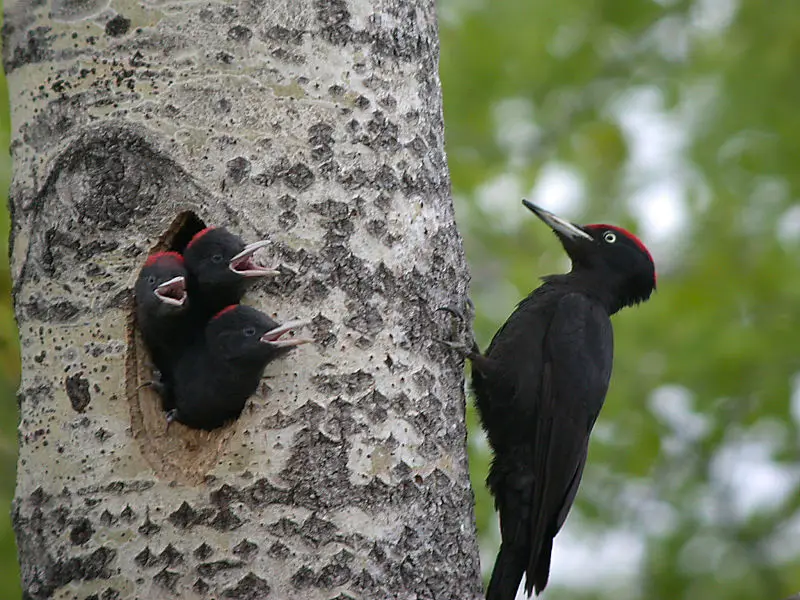
The black woodpecker is an impressive bird found in mature forests across the northern Palearctic region.
It stands out from other species due to its large size and striking black feathers with white spotting on their wings and tail.
Not only is it one of the largest woodpecker species worldwide but also, interestingly, appears to be expanding its range in Europe and Asia as well.
This non-migratory bird loves spending time amongst trees where they can feed off insects which live within tree trunks or branches; tapping away at them with their strong bills until they get a meal.Scientific classification:
| Kingdom | Animalia |
| Phylum | Chordata |
| Class | Aves |
| Order | Piciformes |
| Family | Picidae |
| Genus | Dryocopus |
| Species | D. martius |
3. Common Swift
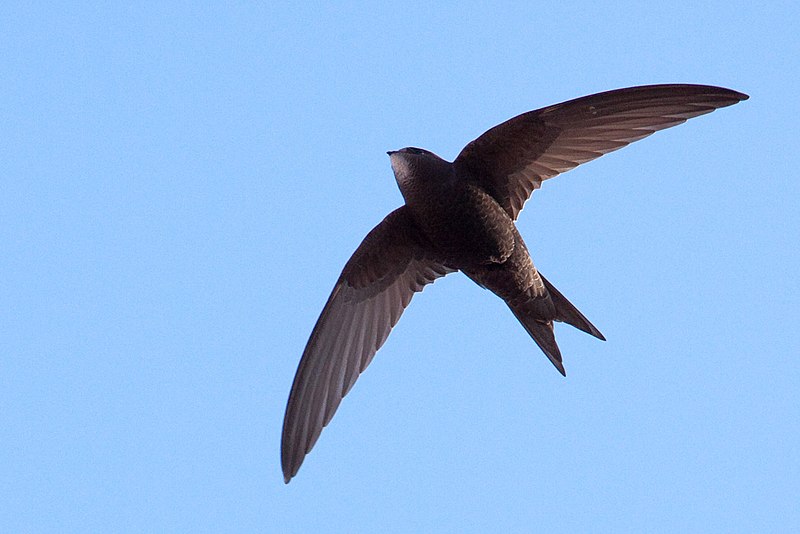
The Common swift is a medium-sized bird with an appearance similar to the barn swallow or house martin.
Its wings are larger, however it is not related to these species but instead belongs in its own order of Apodiformes.
The similarities between the two groups have come about due to convergent evolution and a shared environment.
As for relatives, they can be found among New World hummingbirds and South American swifts; whereas more distant cousins include nightjars as well as treeswifts from Asia/Africa and Australian swiftspecies.
These birds live up high in the air where they remain on constant flight even when sleeping or eating.
They usually migrate south during winter months then return again each springtime bringing life back into our skies.Scientific classification:
| Kingdom | Animalia |
| Phylum | Chordata |
| Class | Aves |
| Order | Apodiformes |
| Family | Apodidae |
| Genus | Apus |
| Species | A. apus |
4. Western Jackdaw
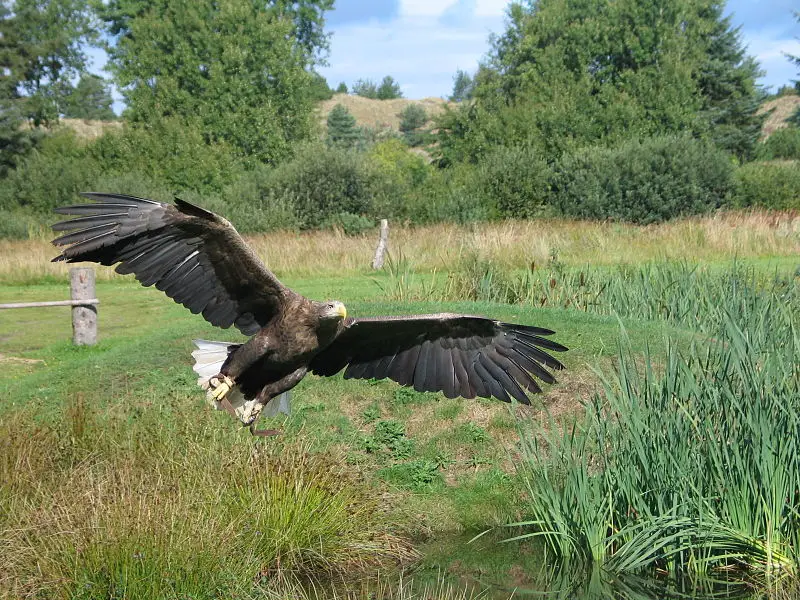
The Western jackdaw is a medium-sized bird native to Europe, Asia and North Africa. It has black feathers with patches of light grey on its wings and head.
The beak and feet are also black in colour with the eyes being yellowish-white. This species lives in small groups or pairs which can often be found perched atop trees or buildings searching for food such as insects, eggs, fruit and grain.
They have an omnivorous diet but prefer scavenging rather than hunting their own prey.
These birds nest high up within crevices of cliffs or walls where they’ll line the nests with soft materials like grasses, twigs and feathers collected from nearby sources – although occasionally these items may come from other species too.
Although classed as least concern by IUCN (International Union For Conservation Of Nature), their populations are decreasing due to loss of habitat caused by humans using more land for agriculture purposes meaning there’s less available nesting sites
5. Alpine Chough
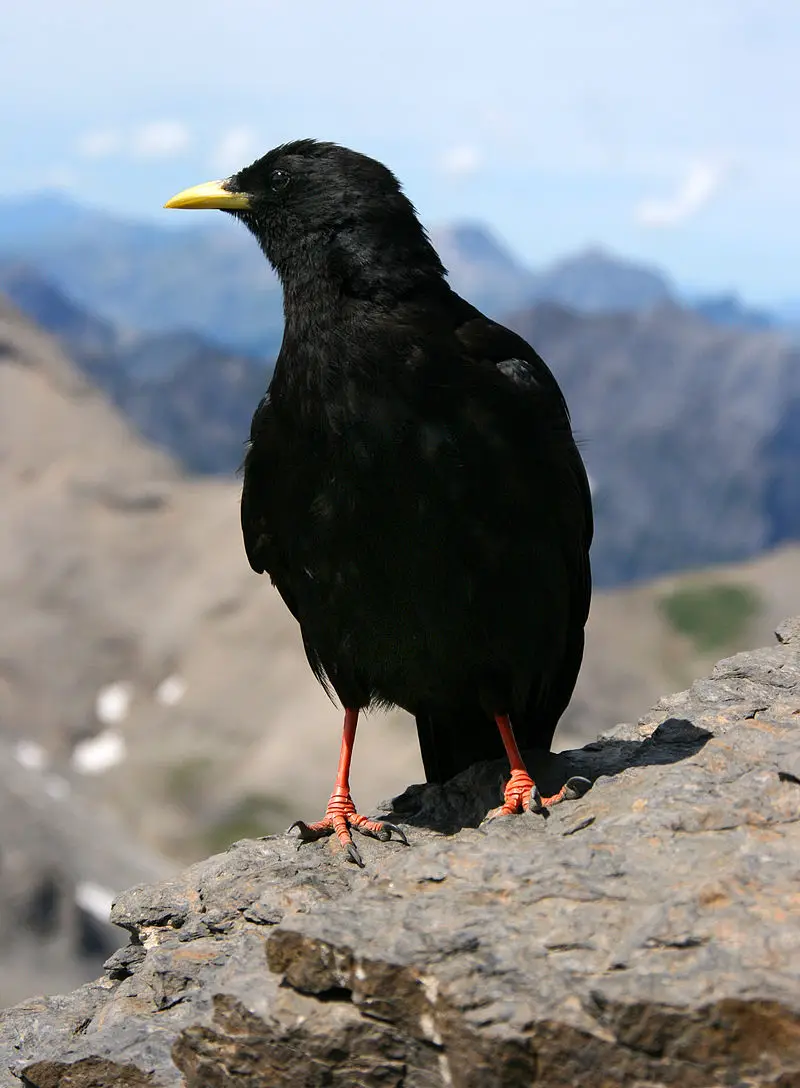
The Alpine chough is a bird in the crow family, distinguished by its yellow beak and black feathers. It has two subspecies that breed in high mountains of Spain, southern Europe and North Africa to Central Asia and Nepal.
This species can nest at incredible altitudes due to special adaptations such as their eggs having extra layers of membranes for protection against thin atmosphere on higher elevations.
The birds feed mainly on insects but have also been known to scavenge carrion or food left out by humans near their nesting sites.
They are agile fliers often seen gliding along cliffs with a characteristic “chack-chack” call which gives them their name.Scientific classification:
| Kingdom | Animalia |
| Phylum | Chordata |
| Class | Aves |
| Order | Passeriformes |
| Family | Corvidae |
| Genus | Pyrrhocorax |
| Species | P. graculus |
6. Bearded Reedling
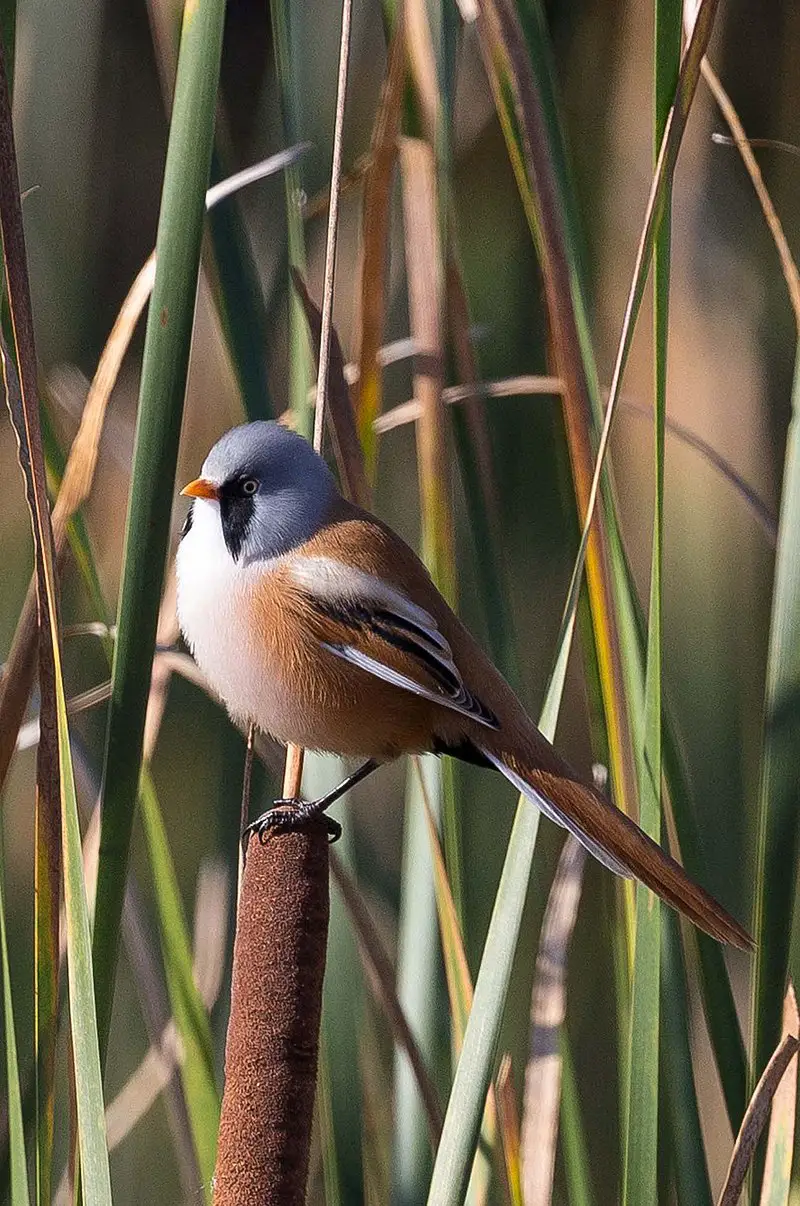
The Bearded Reedling is a small passerine bird found in reed-beds across Europe, Asia and North Africa.
It is easily identified by its distinct black and white plumage with males having yellow faces.
This species belongs to the only family of birds known as Panuridae and was first described by Carl Linnaeus back in 1758.
They feed on insects such as beetles, flies, moths among others but also consume seeds from plants like sedges or rushes during winter months when food availability decreases significantly.
These birds are territorial meaning that they have their own area where they live which can vary from 8 to 12 hectares depending on the seasonality of insect abundance within these areas making them an important part for maintaining healthy ecosystems in wetlands around their range.Scientific classification:
| Kingdom | Animalia |
| Phylum | Chordata |
| Class | Aves |
| Order | Passeriformes |
| Family | Panuridae Des Murs, 1860 |
| Genus | Panurus Koch, 1816 |
| Species | P. biarmicus |
7. Great Cormorant
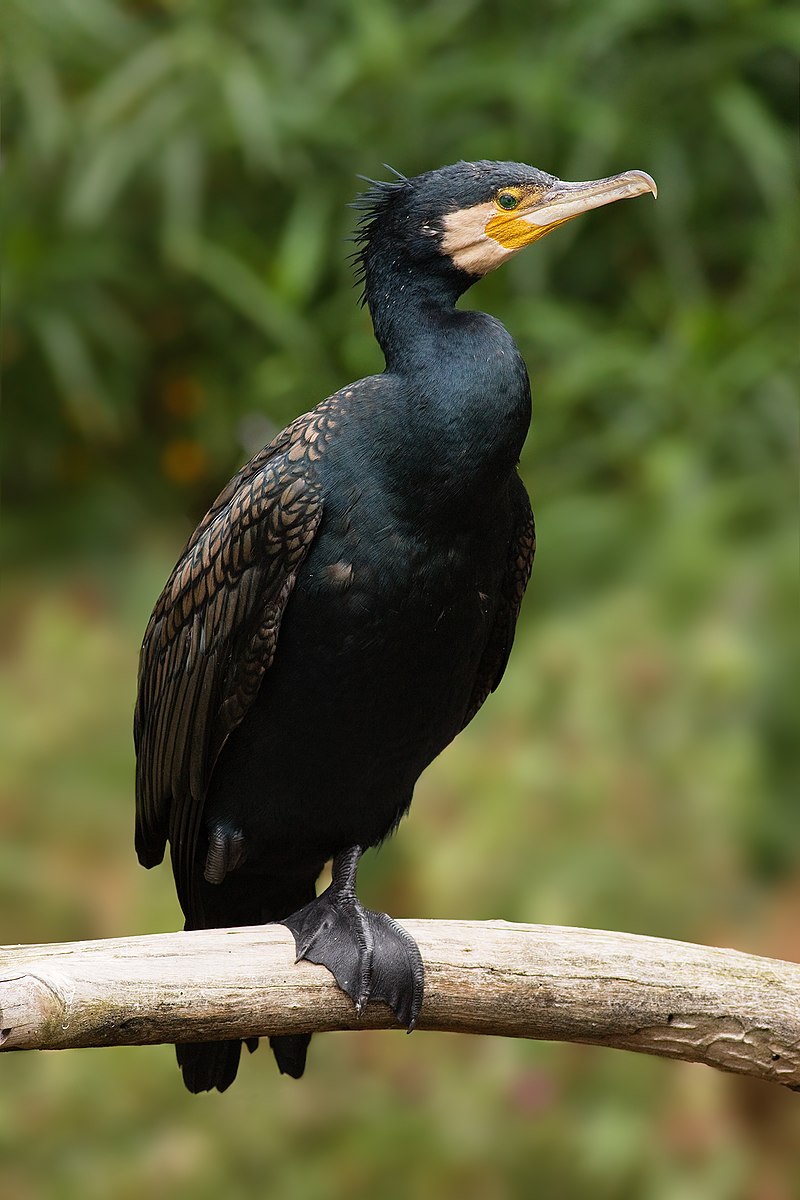
The Great Cormorant is a large seabird belonging to the cormorant family. It has many names, including Black Shag in New Zealand and Large Cormorant in India.
Its striking black feathers make it easy to recognise along coastlines or near bodies of water. The bird can measure up to 1 metre long with a wingspan of around two metres and weighs roughly 3 kilograms.
In flight, its neck is stretched out straight ahead while its bill points downwards – an unmistakable sight for any keen observer.
Cormorants are strong swimmers and excellent divers, frequently going underwater in search of food such as fish or crustaceans that they scavenge from the ocean floor.
They live primarily on coasts but have also been seen inland where there are suitable waterways available – providing another opportunity for nature lovers hoping to catch a glimpse of this impressive species.Scientific classification:
| Kingdom | Animalia |
| Phylum | Chordata |
| Class | Aves |
| Order | Suliformes |
| Family | Phalacrocoracidae |
| Genus | Phalacrocorax |
| Species | P. carbo |
8. Black-Necked Grebe

The Black-necked Grebe is a beautiful water bird belonging to the grebe family. It has an ochre coloured plumage with distinctive features which include extending behind its eyes and over its ear coverts.
The upper parts of this species are black, while their underparts and neck are white in colour.
During breeding season, males develop a dark grey crown on top of their head along with bright yellow facial stripes that run from the beak down to it’s chest area.
These birds feed mainly by diving underwater for insects, crustaceans, larvae, molluscs as well as small fish that they find in shallow waters or wetlands near freshwater lakes or streams.
They can often be spotted swimming alone but during winter months gather together creating large flocks due to mating activity taking place at these times.Scientific classification:
| Kingdom | Animalia |
| Phylum | Chordata |
| Class | Aves |
| Order | Podicipediformes |
| Family | Podicipedidae |
| Genus | Podiceps |
| Species | P. nigricollis |
9. Great Crested Grebe
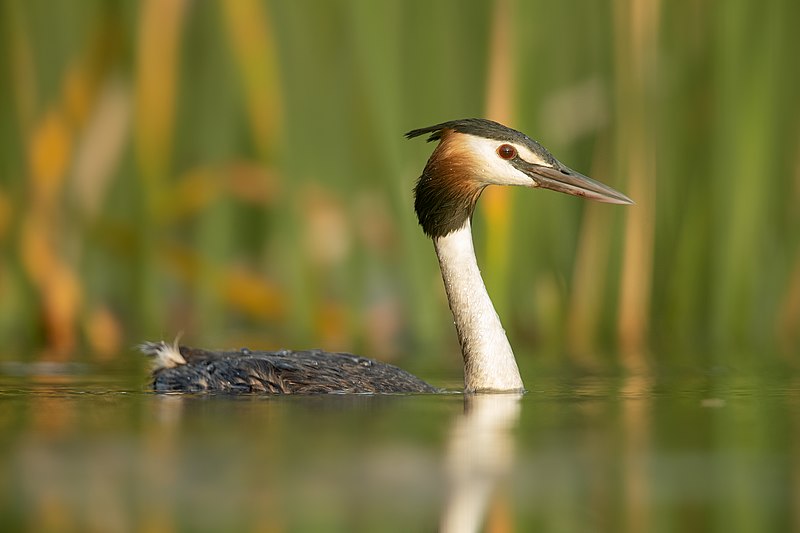
The great crested grebe is a beautiful water bird belonging to the grebe family. It is easily identified by its striking head crest, which it displays during mating rituals.
Originally classified in 1758 by Carl Linnaeus as Colymbus cristatus, this species has since become the type example for all other members of its genus Podiceps.
Great crested grebes are known for their intricate courtship behavior such as synchronized swimming and “head-shaking” motions used to attract mates.
They also possess unique features like red eyes and lobed feet that help them swim efficiently underwater when hunting for food.
The great crested grebe can be found throughout much of Europe, Asia, Africa and Australasia where they inhabit freshwater wetlands or shallow lakeshores with plenty of vegetation nearby to hide from predators while nestingScientific classification:
| Kingdom | Animalia |
| Phylum | Chordata |
| Class | Aves |
| Order | Podicipediformes |
| Family | Podicipedidae |
| Genus | Podiceps |
| Species | P. cristatus |
10. European Turtle Dove
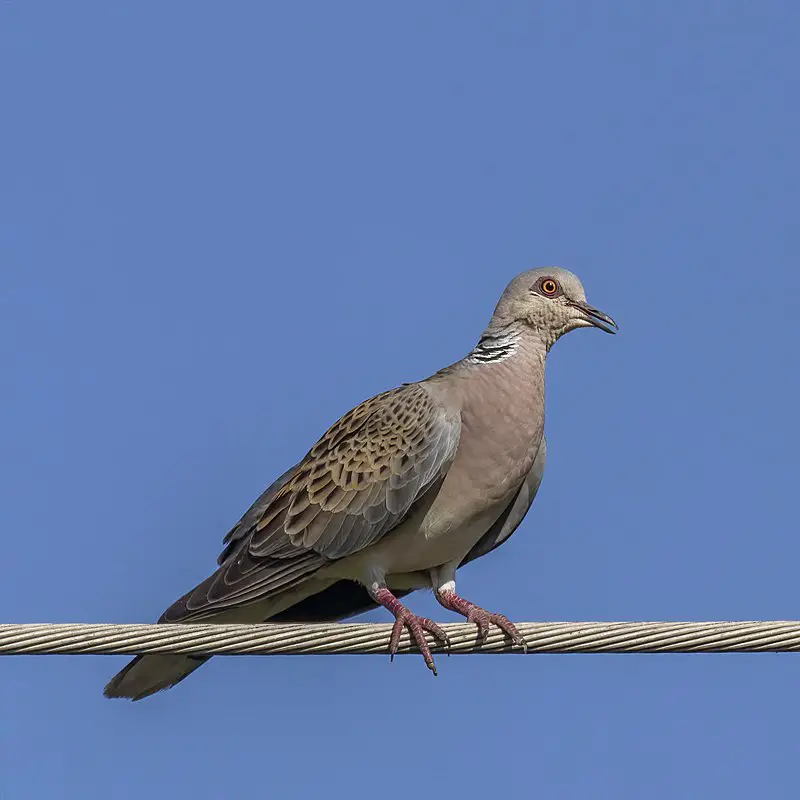
The European turtle dove is a beautiful bird belonging to the Columbidae family of doves and pigeons. It has a wide range across south western Palearctic, including northern Africa, but migrates to sub-Saharan Africa in winter.
The species was officially described by Carl Linnaeus in 1758 as part of his Systema Naturae. This small yet elegant creature can be recognized by its distinctive reddish-brown color with black spots on its wings and tail feathers.
Its underparts are yellowish white while it’s back is grey with dark streaks that run through it making for an attractive patterned plumage.
They feed mainly on grains found on grasslands or near roadsides and have a unique cooing call which makes them easily distinguishable amidst other birdsong.Scientific classification:
| Kingdom | Animalia |
| Phylum | Chordata |
| Class | Aves |
| Order | Columbiformes |
| Family | Columbidae |
| Genus | Streptopelia |
| Species | S. turtur |
11. Common Cuckoo
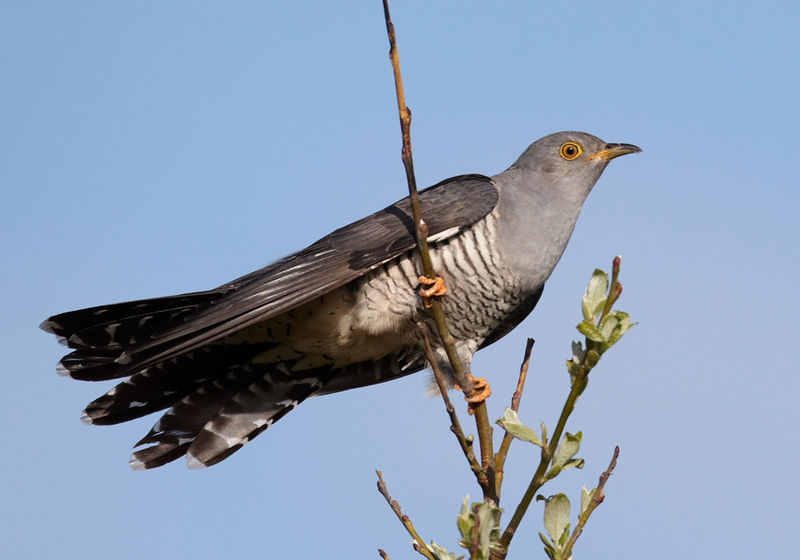
The Common Cuckoo is a medium sized bird belonging to the cuckoo family. It is found in Europe and Asia during summers, migrating to Africa for wintering.
This species has adapted an interesting lifestyle of being a brood parasite – it lays its eggs in other birds’ nests most often that of dunnocks, meadow pipits and reed warblers.
The host bird then incubates the egg as if it were their own which hatches earlier than any other chicks present there thus gaining more attention from the parent birds resulting in better growth rate for Common Cuckoo chicks who are bigger than even their hosts.Scientific classification:
| Kingdom | Animalia |
| Phylum | Chordata |
| Class | Aves |
| Order | Cuculiformes |
| Family | Cuculidae |
| Genus | Cuculus |
| Species | C. canorus |
12. Spotted Crake
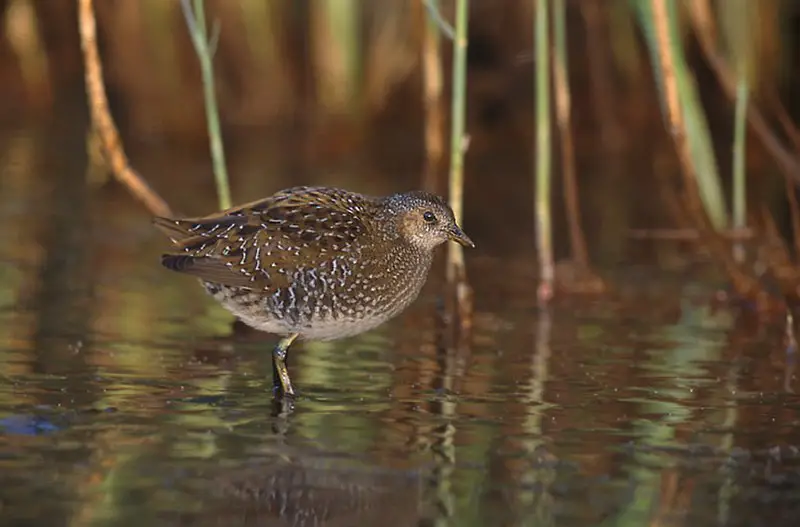
The Spotted Crake is a small waterbird from the family Rallidae, with its scientific name derived from Venetian terms for small rails.
It breeds in marshes and sedge beds across temperate Europe into western Asia and nests on dry locations within marsh vegetation; laying 6-15 eggs.
This species migrates to Africa and Pakistan during winter season. The size of an adult bird can range up to 22.5 cm long, making it one of the smaller birds amongst others in its family but still beautiful nonetheless.
With rich chestnut brown upperparts contrasted by white underparts, they are definitely easy to spot when flying around or simply sitting atop branches nearby ponds or wetlands.Scientific classification:
| Kingdom | Animalia |
| Phylum | Chordata |
| Class | Aves |
| Order | Gruiformes |
| Family | Rallidae |
| Genus | Porzana |
| Species | P. porzana |
Also Featured In: Common Slovakian Birds,
13. Northern Goshawk
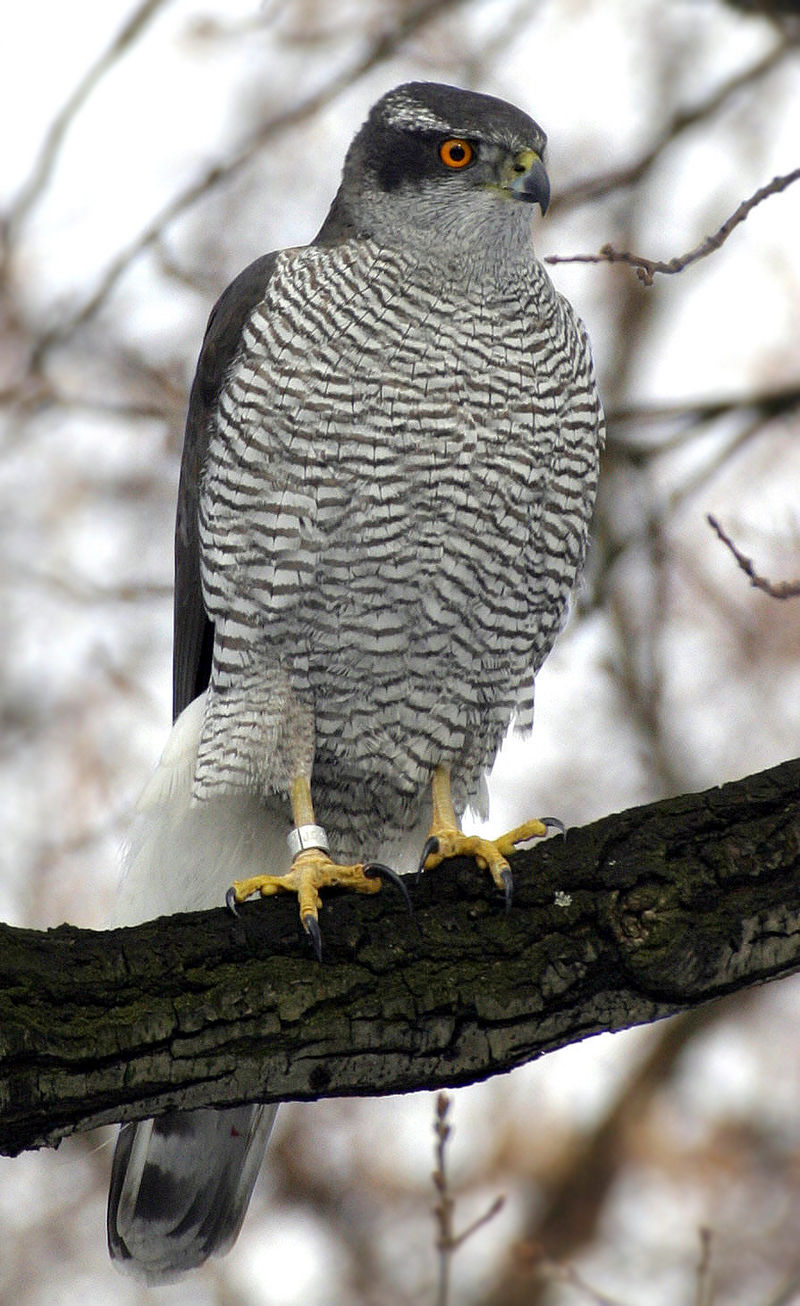
The Northern Goshawk is a medium-large bird of prey belonging to the Accipitridae family. It has been known as one of the true hawks, with “Accipiter” meaning hawk in Latin and “gentilis” referring to its noble characteristics.
They are found worldwide, most commonly in wooded areas such as forests or thickets where they hunt small birds and mammals.
The males have spotted grey upperparts while females tend to be fully brown above with some lighter barring on their underparts.
These raptors rely heavily on speed and agility when hunting from either perches or during aerial dives at high speeds for their prey which makes them formidable predators that can reach up to 40 mph.Scientific classification:
| Kingdom | Animalia |
| Phylum | Chordata |
| Class | Aves |
| Order | Accipitriformes |
| Family | Accipitridae |
| Genus | Accipiter |
| Species | A. gentilis |
14. White-Tailed Eagle
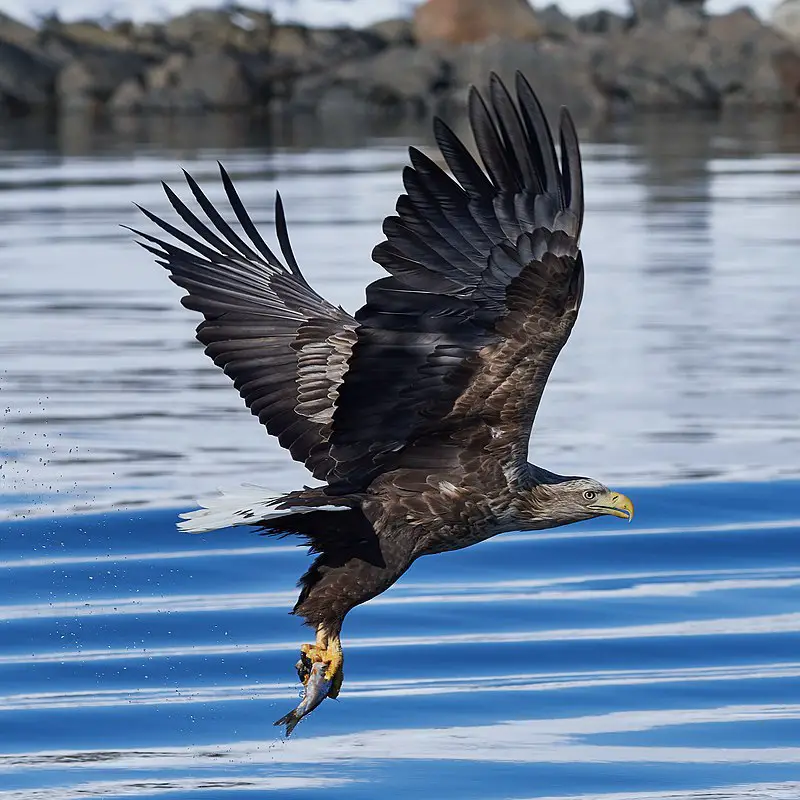
The white-tailed eagle is an impressive species of sea eagle found across temperate Eurasia. This majestic bird belongs to the family Accipitridae, which includes hawks, kites and harriers.
It has a wingspan of up to 2.5 meters and can weigh 4 kilograms or more.
The plumage varies in colour from dark brown above with paler head and neck while its tail is pure white – hence it’s name.
They feed mainly on fish but will also take small mammals, birds and carrion when available.
White-tailed eagles are solitary by nature but form pairs during nesting season typically near bodies of water such as lakes or coasts where they build large stick nests on trees or cliffsides for their young ones to hatch safely in peace.Scientific classification:
| Kingdom | Animalia |
| Phylum | Chordata |
| Class | Aves |
| Order | Accipitriformes |
| Family | Accipitridae |
| Genus | Haliaeetus |
| Species | H. albicilla |
15. Eurasian Nuthatch
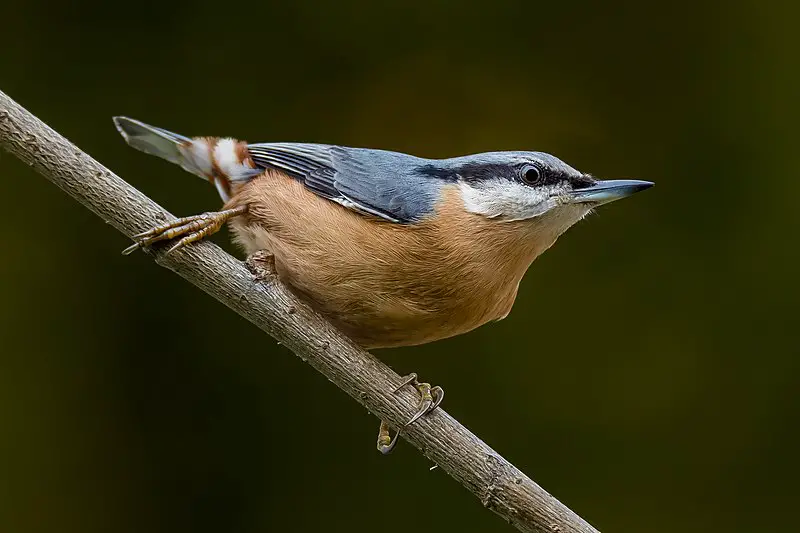
The Eurasian nuthatch is a small passerine bird found in the Palearctic region, most commonly in Europe. It has blue-gray upper parts, an orange-buff underbelly, and a black eye stripe.
The distinctive characteristic of this species is its loud dwip call which can be heard throughout its range.
This species has more than 20 subspecies divided into three main groups based on their geographical ranges.
Those from western regions having the buffest coloration while eastern birds are greyer overall.
They usually feed on insects and spiders but also eat nuts and seeds when available, often storing them for later use by wedging them into bark crevices or similar places to retrieve later as needed.Scientific classification:
| Kingdom | Animalia |
| Phylum | Chordata |
| Class | Aves |
| Order | Passeriformes |
| Family | Sittidae |
| Genus | Sitta |
| Species | S. europaea |
16. Eurasian Eagle-Owl
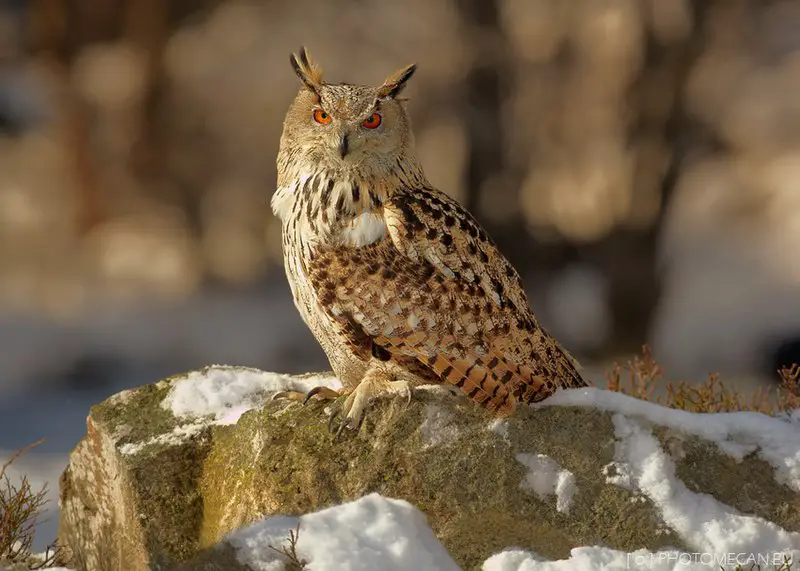
The Eurasian eagle-owl is a majestic bird that inhabits much of Eurasia. It has an impressive wingspan of up to 6 ft 2 in, and females can reach lengths of 30 inches.
The Uhu, as it is sometimes called, boasts distinctive ear tufts which are easily visible against its mottled brown plumage.
This powerful owl preys on small mammals like rodents and hares; however due to their large size they have been known to hunt larger prey such as foxes or even deer.
They usually nest in cavities located high off the ground but will also use manmade structures if available.
With their prominent presence across Europe, these birds are often seen perched atop trees during the day before setting out for hunting at night – truly magnificent creatures.Scientific classification:
| Kingdom | Animalia |
| Phylum | Chordata |
| Class | Aves |
| Order | Strigiformes |
| Family | Strigidae |
| Genus | Bubo |
| Species | B. bubo |
17. Skuas
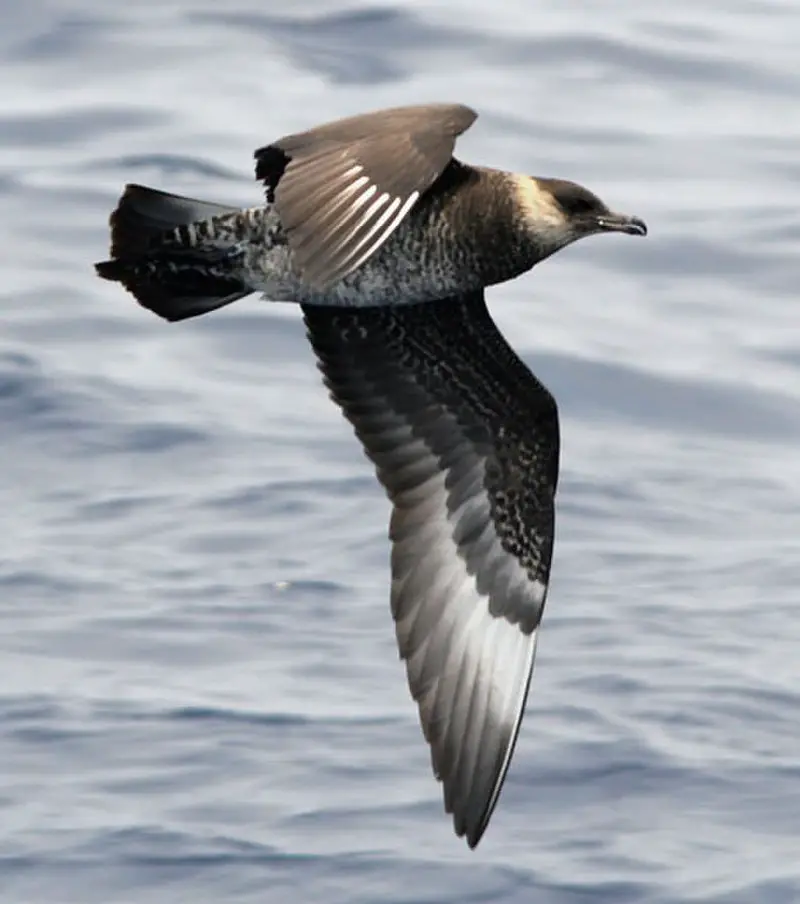
Skuas are a group of predatory seabirds with seven species, all belonging to the genus Stercorarius.
They are also known as “Jaegers” in North America and their name originates from the Faroese word for Great Skua – skúgvur.
These birds typically inhabit coastal areas or open oceans where they feed on fish, krill and other marine creatures.
Skuas can be distinguished by their pointed wings which help them fly long distances while hunting food.
Their distinctive colouration varies depending on age and habitat but generally includes greyish brown upperparts and white underparts with black streaks along its belly area.
The overall size ranges from 24-40 cm making these one of the larger sea bird species.Scientific classification:
| Kingdom | Animalia |
| Phylum | Chordata |
| Class | Aves |
| Order | Charadriiformes |
| Suborder | Lari |
| Family | Stercorariidae Gray, 1871 |
| Genus | Stercorarius Brisson, 1760 |
18. Aquatic Warbler
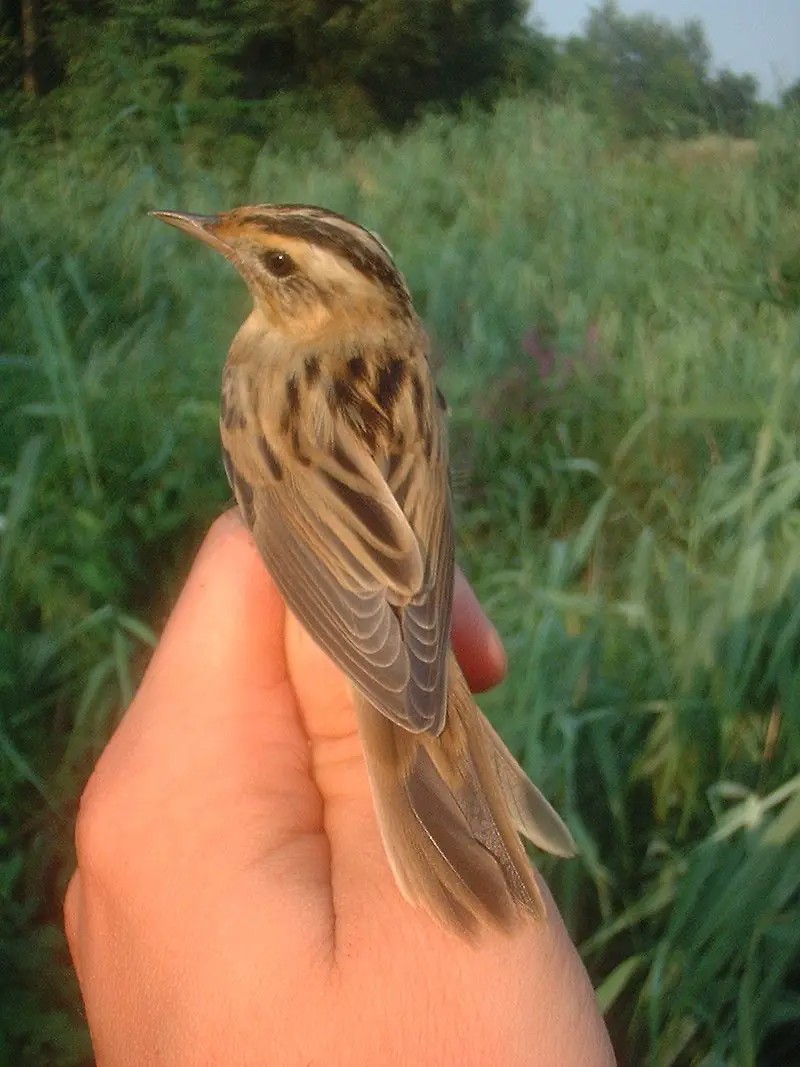
The Aquatic Warbler is a species of Old World warbler that can be found breeding in temperate eastern Europe and western Asia. It has an estimated population of 11,000-15,000 pairs.
This bird migrates during winter to west Africa where it spends its time until the spring months when it returns for the summer season.
Its exact whereabouts were unknown for many years but researchers eventually located them at Djoudj National Bird Sanctuary near Mauritania on the edge of the Sahara Desert.
They prefer wetland habitats such as marshes with dense reed beds which offer a suitable environment to nest and feed their young successfully each year.
With conservation efforts this species will hopefully continue to thrive in its natural habitat over coming years.Scientific classification:
| Kingdom | Animalia |
| Phylum | Chordata |
| Class | Aves |
| Order | Passeriformes |
| Family | Acrocephalidae |
| Genus | Acrocephalus |
| Species | A. paludicola |
19. Parasitic Jaeger
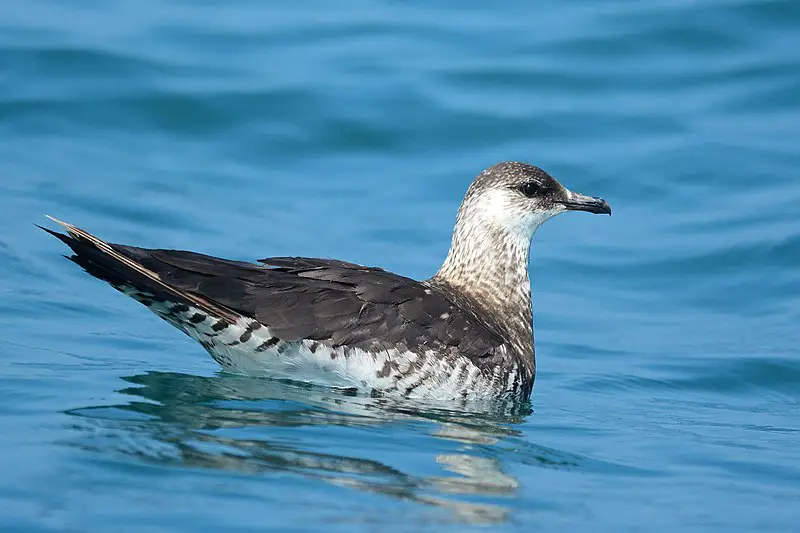
The Parasitic Jaeger is a migratory bird that breeds in cold climates of Northern Scandinavia, Scotland, Iceland, Greenland and parts of Canada, Alaska and Siberia.
During the breeding season it feeds primarily on kleptoparasitism – stealing food from other birds.
In winter they migrate to warmer regions across the southern hemisphere where they feed mainly by scavenging off fish or carrion left behind by fishing boats or whales.
This species is easily identified by its brownish-gray plumage with white patches on its wings and tail feathers as well as yellow eyes which are quite distinctive among skuas.
The parasitic jaeger has adapted to many different habitats ranging from coastal areas to inland lakes making them an interesting species to watch out for while exploring nature.Scientific classification:
| Kingdom | Animalia |
| Phylum | Chordata |
| Class | Aves |
| Order | Charadriiformes |
| Family | Stercorariidae |
| Genus | Stercorarius |
| Species | S. parasiticus |
20. Tawny Owl
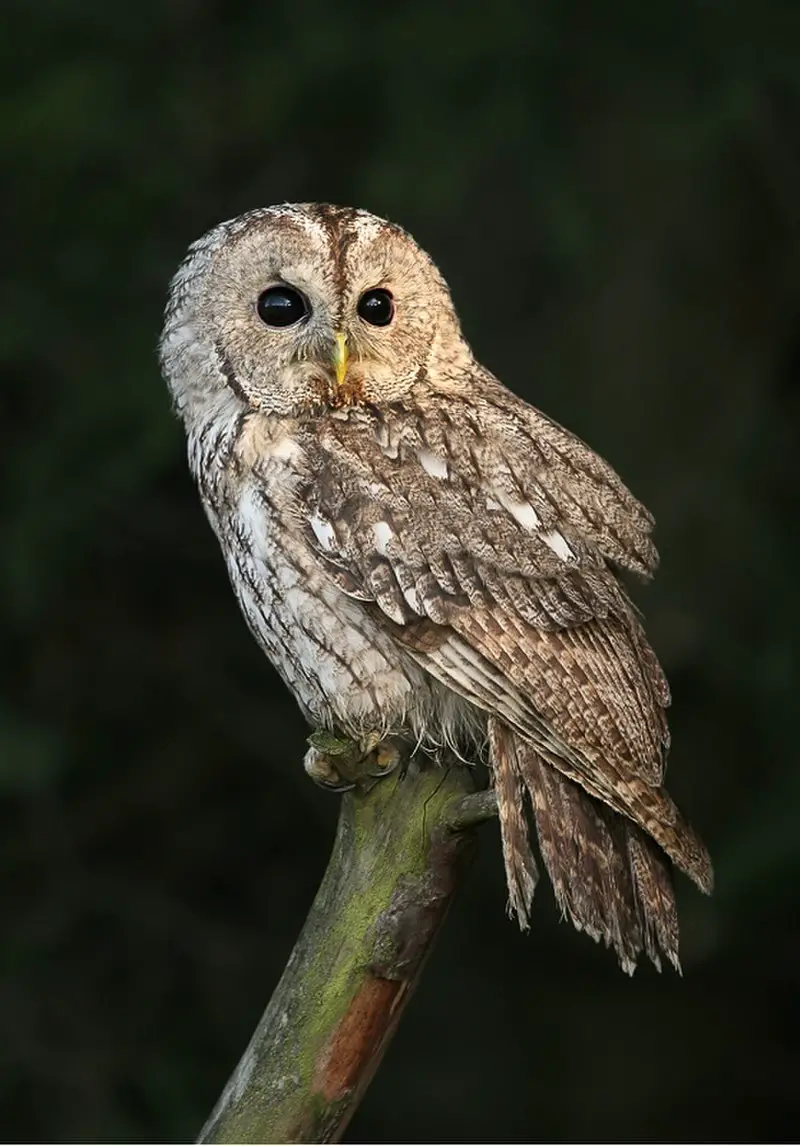
The Tawny Owl is a stunning bird found in woodlands throughout Europe to western Siberia. It has seven recognized subspecies, each with its own subtle differences.
This stocky owl usually has pale underparts with dark streaks and either brown or gray upper feathers. They build their nests high up in tree holes and are very territorial when it comes to protecting them.
During the day they roost quietly among branches of trees but become quite active at night as they hunt small mammals like mice and shrews using their extraordinary hearing skills.
The tawny owl’s call can be heard echoing through forests on still nights making it one of the most recognizable owls around.Scientific classification:
| Kingdom | Animalia |
| Phylum | Chordata |
| Class | Aves |
| Order | Strigiformes |
| Family | Strigidae |
| Genus | Strix |
| Species | S. aluco |
21. Red Kite
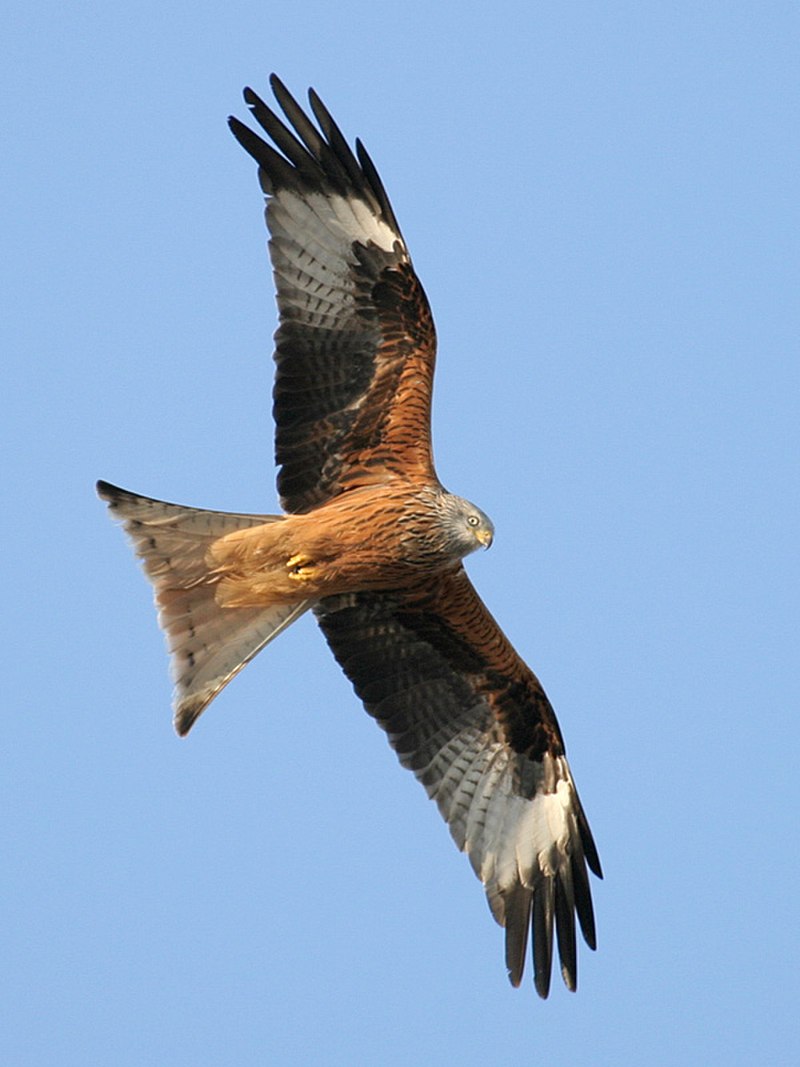
The Red Kite is a magnificent bird of prey, belonging to the family Accipitridae. It can be found in western Europe and northwest Africa where it breeds, while also occurring occasionally in northern Iran.
These birds are medium-large size with wingspans ranging from 125 – 170 cm wide. They have reddish brown plumage on their upperparts and pale gray underneath.
The Red Kite feeds mainly on small mammals, carrion and insects which they hunt for by soaring through the air using thermals to gain altitude before diving down onto its prey.
Furthermore, this species has adapted well to human presence since it often scavenges near roadsides or rubbish dumps as an easy source of food.
All things considered, these majestic creatures make up a beautiful part of our natural environment that should definitely not go unnoticed.Scientific classification:
| Kingdom | Animalia |
| Phylum | Chordata |
| Class | Aves |
| Order | Accipitriformes |
| Family | Accipitridae |
| Genus | Milvus |
| Species | M. milvus |
22. Red-Throated Loon
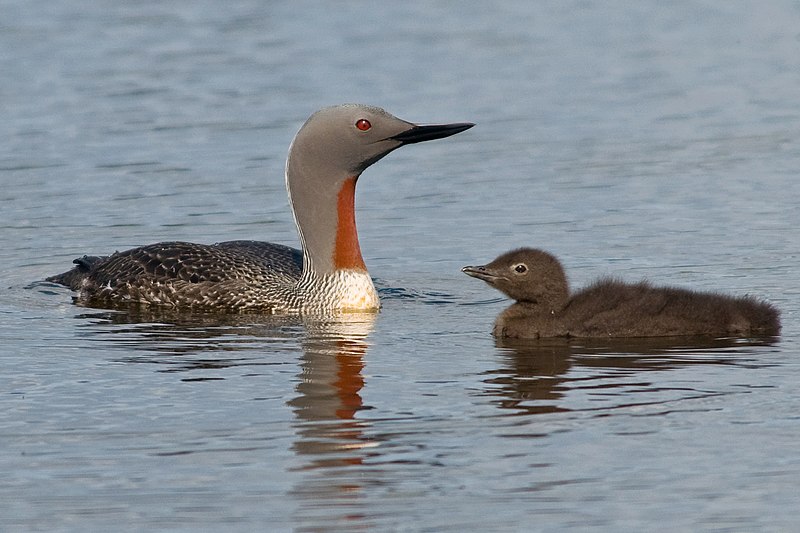
The Red-throated Loon is a migratory bird found in the northern hemisphere, with its breeding grounds primarily located in Arctic regions and wintering spots near coastal waters.
With an average length of 55 – 67 cm (22 – 26 inches), it’s the smallest member of the loon or diver family.
Its namesake comes from its bright red throat patch which contrasts against its white underside and grey back.
This species has adapted to life on icy seas; they are strong swimmers with powerful wings for long flights over open water when migrating seasonally.
Their diet consists mostly of fish but can also include crustaceans, molluscs, amphibians and insects depending on availability.Scientific classification:
| Kingdom | Animalia |
| Phylum | Chordata |
| Class | Aves |
| Order | Gaviiformes |
| Family | Gaviidae |
| Genus | Gavia |
| Species | G. stellata |
23. Eurasian Crag Martin
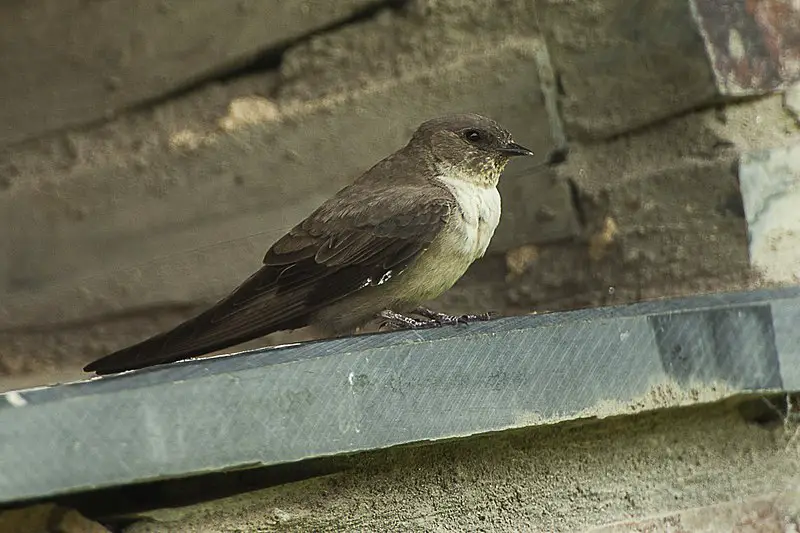
The Eurasian crag martin is a small passerine bird in the swallow family, measuring 14 cm long.
It boasts ash-brown upperparts and paler underparts, with a short square tail featuring white patches on most of its feathers.
This species breeds in southern Europe, northwestern Africa and across the Palearctic region.
Though similar looking to other martins such as Alpine or Rock Martins, it can be distinguished by the less extensive dark markings on its neck and throat area that lack any brownish tinge.
Crag Martin’s diet consists mainly of insects which are caught while flying low over open areas near rocks or cliffs – hence their name.Scientific classification:
| Kingdom | Animalia |
| Phylum | Chordata |
| Class | Aves |
| Order | Passeriformes |
| Family | Hirundinidae |
| Genus | Ptyonoprogne |
| Species | P. rupestris |
24. Common Kingfisher
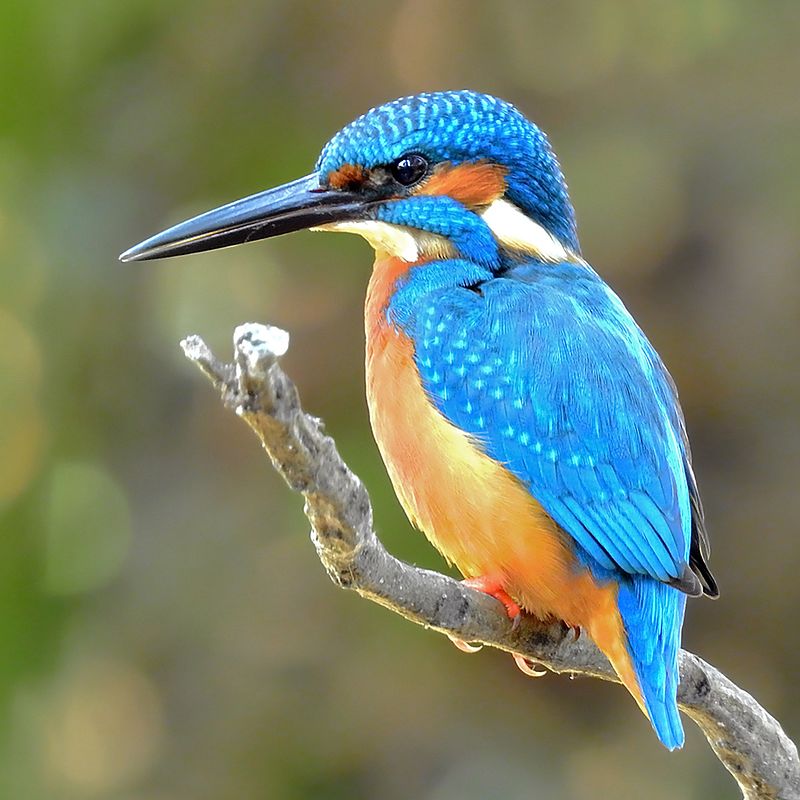
The Common Kingfisher is a small, sparrow-sized bird that can be found across Eurasia and North Africa. It has the typical short tail and large head of kingfishers with seven different subspecies recognized in its range.
They are mainly resident birds but will migrate away during winter when rivers freeze over. The species usually live near bodies of water such as streams or lakes.
Where they hunt for fish by diving from above into the water after spotting their prey below them.
These brightly coloured birds have an unmistakable vibrant blue plumage along with orange underparts and white patches on their wings which makes them easy to recognize amongst other similar looking species.
Their call is loud and shrill making it one of the most recognizable sounds heard around wetlands throughout Europe.Scientific classification:
| Kingdom | Animalia |
| Phylum | Chordata |
| Class | Aves |
| Order | Coraciiformes |
| Family | Alcedinidae |
| Subfamily | Alcedininae |
| Genus | Alcedo |
| Species | A. atthis |
25. Common House Martin
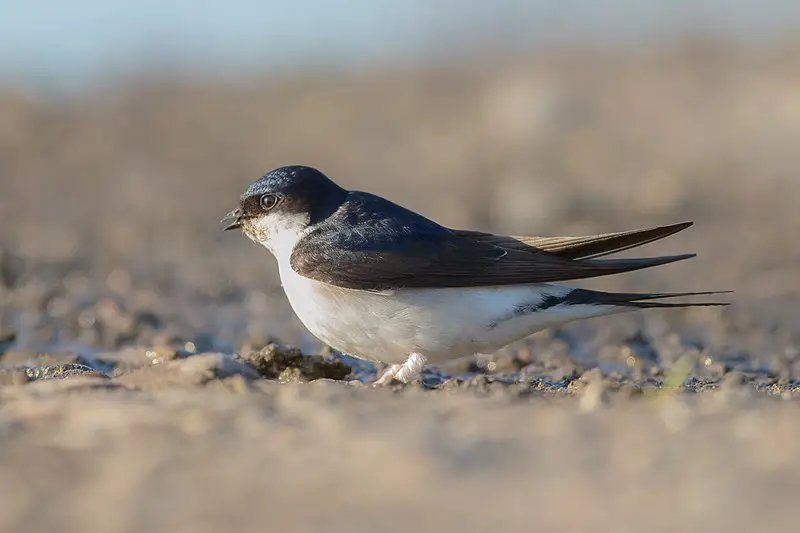
The Common House Martin is a beautiful migratory bird of the swallow family. It breeds in Europe, North Africa and across the Palearctic region, then winters in sub-Saharan Africa and tropical Asia.
This species feeds on insects caught while flying through its habitat.
Its main food source changes depending on where it is located at any given time as it follows warmer climates with more abundance of flies during winter months when migrating southward from its breeding grounds up north.
The house martin has an unmistakable appearance; they have glossy blue upperparts and white underparts that contrast beautifully against their black wingspan which can reach up to 18 cm long.Scientific classification:
| Kingdom | Animalia |
| Phylum | Chordata |
| Class | Aves |
| Order | Passeriformes |
| Family | Hirundinidae |
| Genus | Delichon |
| Species | D. urbicum |
26. Great Grey Shrike
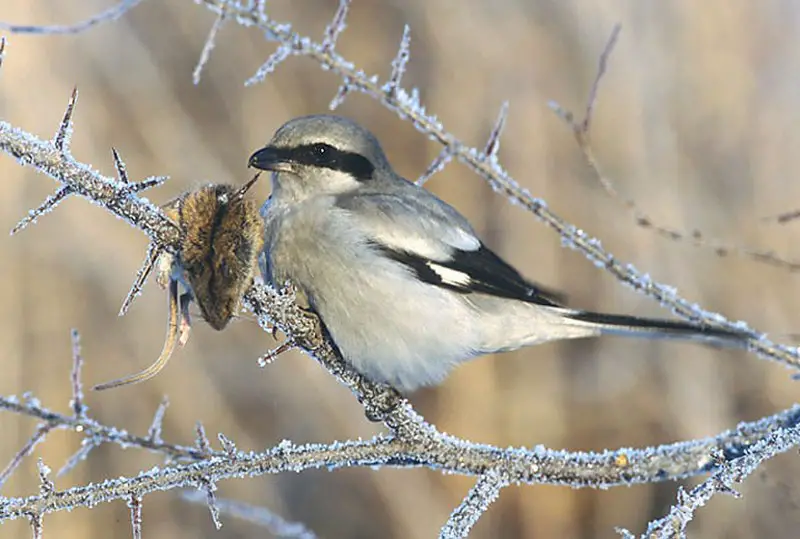
The Great Grey Shrike is a predatory songbird of the shrike family. It has a pearly grey plumage and striking black eye-mask, making it an attractive species to watch.
Males and females are alike in their plumage, however males have larger heads and longer tails than those of the female birds. This bird can be found across Europe, Asia, North America, Canada and Alaska.
They prefer open habitats such as grasslands or scrubby areas where they can hunt for small mammals like mice or voles from exposed perches on tree branches or hedgerows – this behaviour gives them their nickname of ‘Butcher Bird’.
The population numbers for these birds remain stable but there is some concern about habitat loss due to agricultural intensification which could potentially lead to decreased populations in future years.Scientific classification:
| Kingdom | Animalia |
| Phylum | Chordata |
| Class | Aves |
| Order | Passeriformes |
| Family | Laniidae |
| Genus | Lanius |
| Species | L. excubitor |
Also Featured In: Autumn Birds You Should Know, Birds of Lanzarote
27. Eurasian Wryneck
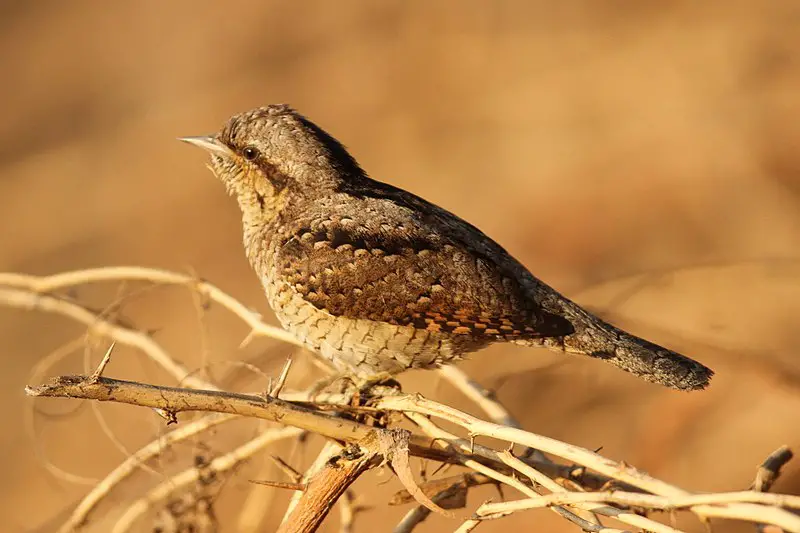
The Eurasian Wryneck is a species of woodpecker found in temperate regions of Europe and Asia. They breed during the summer months, but migrate south to tropical Africa or southern Asia for winter.
These birds are quite adaptable when it comes to their habitat, as they can be seen in open countryside, woodland, orchards and gardens alike.
To identify them you should look out for their distinctive brownish-grey feathers with black bars on the wings and tail; males also have red markings around their neck too.
Their diet consists mainly of insects which they find by probing into loose bark on trees or digging through soil with its sharp bill.
All in all an amazing bird that deserves more attention.Scientific classification:
| Kingdom | Animalia |
| Phylum | Chordata |
| Class | Aves |
| Order | Piciformes |
| Family | Picidae |
| Genus | Jynx |
| Species | J. torquilla |
28. Common Snipe
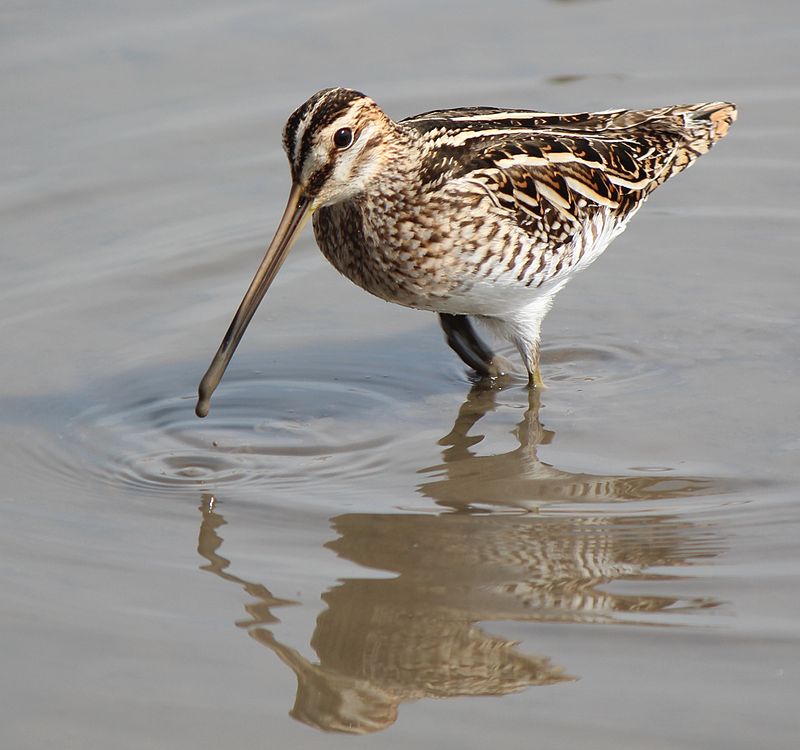
The Common Snipe is a small wader bird that can be found throughout the Palearctic region, from Iceland to northern Russia and Siberia. It breeds in marshes, bogs, tundra and wet meadows during summertime.
Its diet consists of earthworms and insects which it finds by probing with its long bill into soft ground.
During winter months they migrate southwards in search of more favourable conditions for breeding; however their exact migration routes remain unknown.
These birds are fairly secretive but can often be seen skulking around wetlands using their cryptic mottled brown plumage as camouflage against predators.
They have an unmistakable flight pattern – rapid bursts of wing-beats interspersed with glides – making them one of the most distinctive species on our planet.Scientific classification:
| Kingdom | Animalia |
| Phylum | Chordata |
| Class | Aves |
| Order | Charadriiformes |
| Family | Scolopacidae |
| Genus | Gallinago |
| Species | G. gallinago |
29. Eurasian Skylark
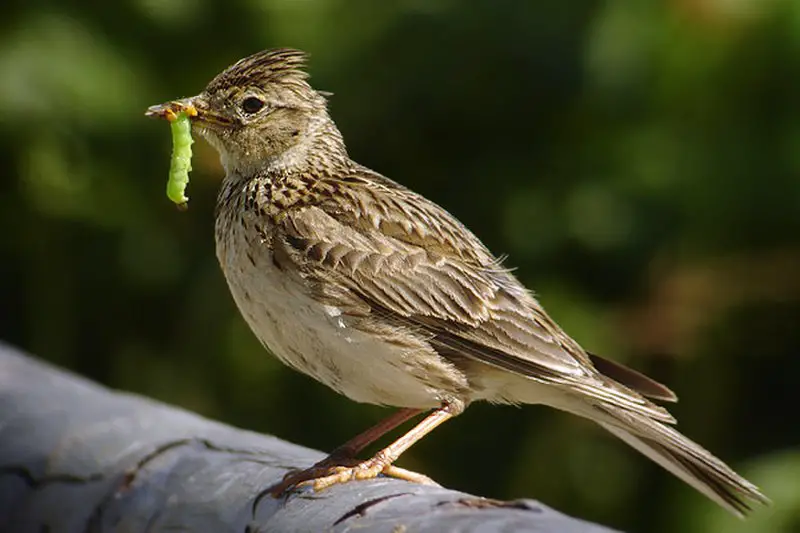
The Eurasian skylark is a medium-sized bird belonging to the lark family, Alaudidae. It inhabits open areas such as farmland and heathland across Europe and the Palearctic region.
The most notable characteristic of this species is its male’s song which is delivered in an impressive hovering flight from heights ranging between 50 – 100 metres (160 – 330 ft).
This beautiful bird has been introduced to New Zealand, Australia and Hawaii Islands too.
Its main diet consists of insects but it also feeds on seeds, grains and some vegetation during wintertime when food sources become scarce.
The males are known for their elaborate courtship display involving high flights with trills that can be heard up to 2 km away.Scientific classification:
| Kingdom | Animalia |
| Phylum | Chordata |
| Class | Aves |
| Order | Passeriformes |
| Family | Alaudidae |
| Genus | Alauda |
| Species | A. arvensis |
30. River Warbler
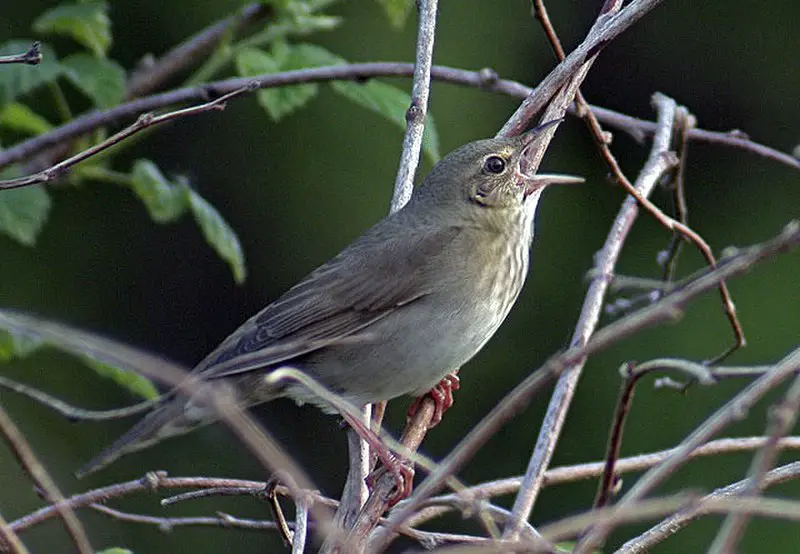
The River Warbler is a small bird in the grass warbler genus Locustella. It can be found breeding in eastern and central Europe, as well as throughout the western Palearctic region.
During winter it migrates to inland Southern Africa from around the Zambezi River all the way down south of Pretoria.
Its name comes from its Latin diminutive “locusta” meaning grasshopper due to its habit of foraging for insects on low vegetation near water bodies like rivers or streams.
This bird has olive-brown upperparts with whitish underparts which have black streaks across them.
These streaked feathers help it blend into its natural habitat making it difficult to spot against reeds and tall grasses growing along riverbanks and wetland areas where they often frequent during migration season looking for food sources such as flying insects or small crustaceans that inhabit those environments.Scientific classification:
| Kingdom | Animalia |
| Phylum | Chordata |
| Class | Aves |
| Order | Passeriformes |
| Family | Locustellidae |
| Genus | Locustella |
| Species | L. fluviatilis |
31. Eurasian Reed Warbler
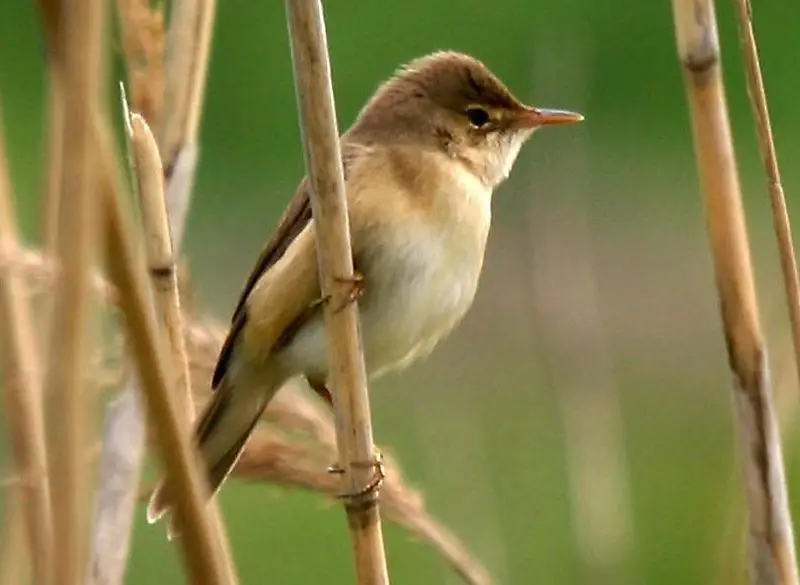
The Eurasian reed warbler (Acrocephalus scirpaceus) is a species of Old World Warbler native to the temperate parts of Europe and Asia.
It breeds in wetlands such as marshes, ponds and rivers with dense vegetation like reeds or tall grasses.
During its wintering season, it migrates southward to sub-Saharan Africa where there are milder conditions.
This small bird has streaked brown plumage on the upperparts and white underparts which makes it difficult for predators to spot among the foliage.
Its diet consists mainly of insects including aphids, caterpillars larvae and moths caught while flying over water or by gleaning from plants growing near water bodies.
The male sings an attractive song consisting of several phrases repeated one after another as part of their courtship display during breeding season in order attract females for mating purposes.Scientific classification:
| Kingdom | Animalia |
| Phylum | Chordata |
| Class | Aves |
| Order | Passeriformes |
| Family | Acrocephalidae |
| Genus | Acrocephalus |
| Species | A. scirpaceus |
32. Eurasian Penduline Tit
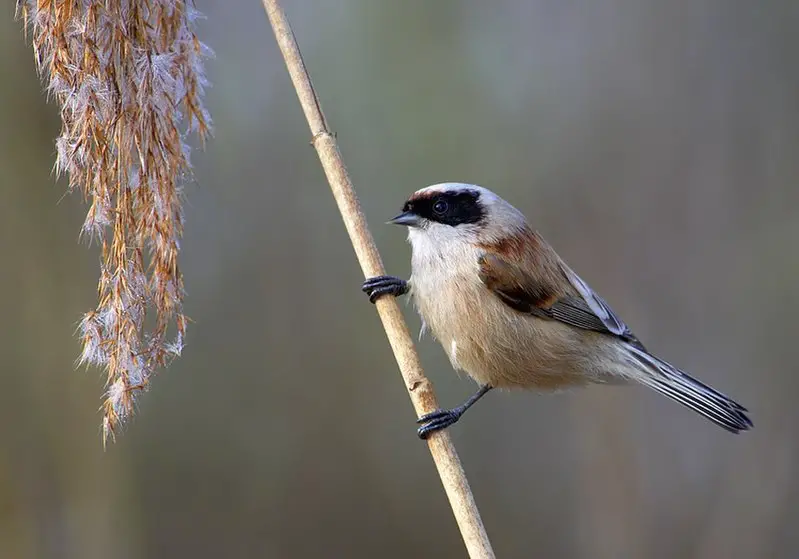
The Eurasian penduline tit is a passerine bird of the genus Remiz which can be found widely across the western Palearctic.
It migrates to more northern parts in summer, while staying resident in its southern range during winter months.
This species experienced an expansion of its breeding grounds throughout Western Europe between 1980s and 1990s, thus increasing its population significantly.
The Penduline Tit has various striking features like bright yellow underparts with black streaks on sides.
Greyish-brown upper part with white underside and pale eye line along head sides as well as distinctive tail nest made from fibers and mosses hanging from trees or shrubs like a pendulum hence their name ‘Penduline’.
These birds feed mainly on insects but also eat some seeds especially sunflower seeds making them popular garden visitors for many people.Scientific classification:
| Kingdom | Animalia |
| Phylum | Chordata |
| Class | Aves |
| Order | Passeriformes |
| Family | Remizidae |
| Genus | Remiz |
| Species | R. pendulinus |
33. Common Kestrel
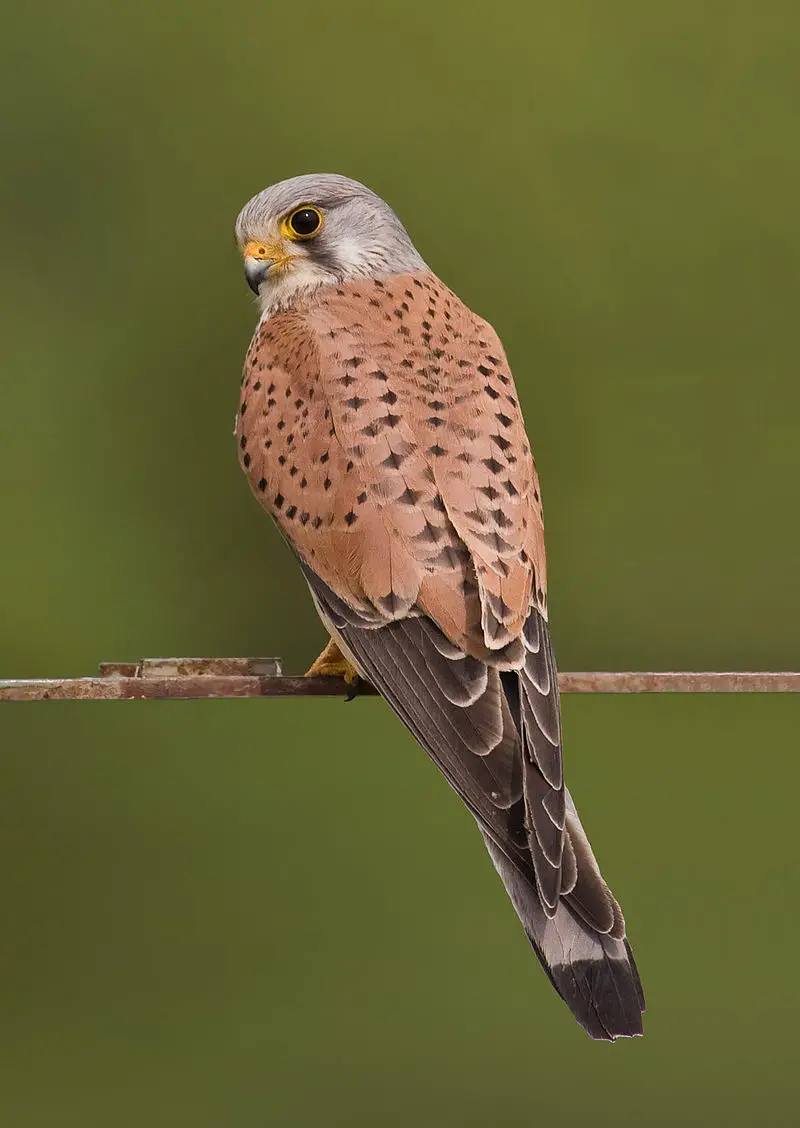
The Common Kestrel is a species of bird belonging to the kestrel group of Falconidae. It can be found in Europe, Asia and parts of Africa, though it is most commonly seen in the United Kingdom where it’s simply referred to as “Kestrel”.
This falcon has powerful talons and exceptional vision which makes them adept hunters who feed on small mammals such as voles or mice.
They are also renowned for their hovering flight – they will hover up high and scan with amazing accuracy below until they spot prey beneath them.
The beautiful plumage on this raptor varies from country to country but generally consists of shades ranging from grey-browns through chestnut reds with tawny hues around its face area.Scientific classification:
| Kingdom | Animalia |
| Phylum | Chordata |
| Class | Aves |
| Order | Falconiformes |
| Family | Falconidae |
| Genus | Falco |
| Species | F. tinnunculus |
34. Barn Swallow
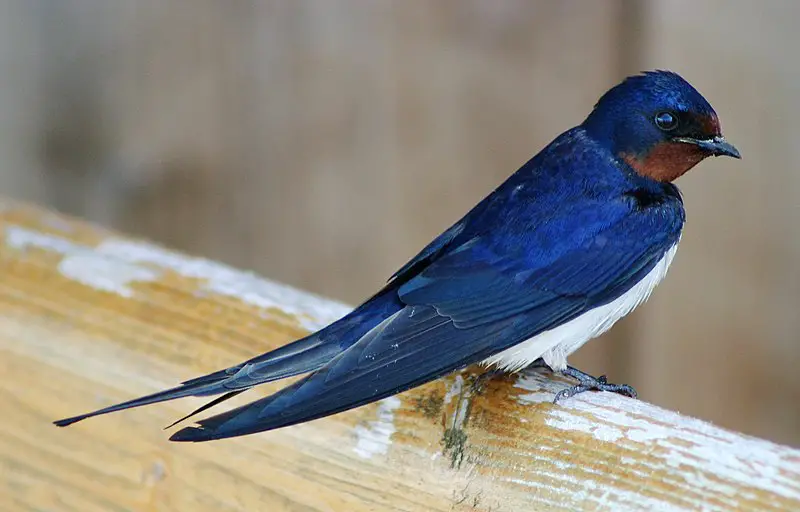
The Barn Swallow is a beautiful passerine bird with blue upperparts and a long, deeply forked tail. Found in Europe, Asia, Africa and the Americas.
It has an astonishingly large natural distribution spanning 251 million square kilometres globally; likely making it one of the world’s most widespread species.
This swallow typically nests near human habitation as well as other open areas such as fields or grasslands which provide them with suitable invertebrate prey to feed on.
They are insectivorous birds that often fly together in flocks looking for food over rivers or marshes usually just above tree-top level.
The barn swallow can also be identified by its strong flight consisting of swift continuous wing beats interspersed with glides during which they hold their wings slightly raised at the shoulders giving them distinct V shaped silhouettes in the sky.Scientific classification:
| Kingdom | Animalia |
| Phylum | Chordata |
| Class | Aves |
| Order | Passeriformes |
| Family | Hirundinidae |
| Genus | Hirundo |
| Species | H. rustica |
35. Black-Tailed Godwit
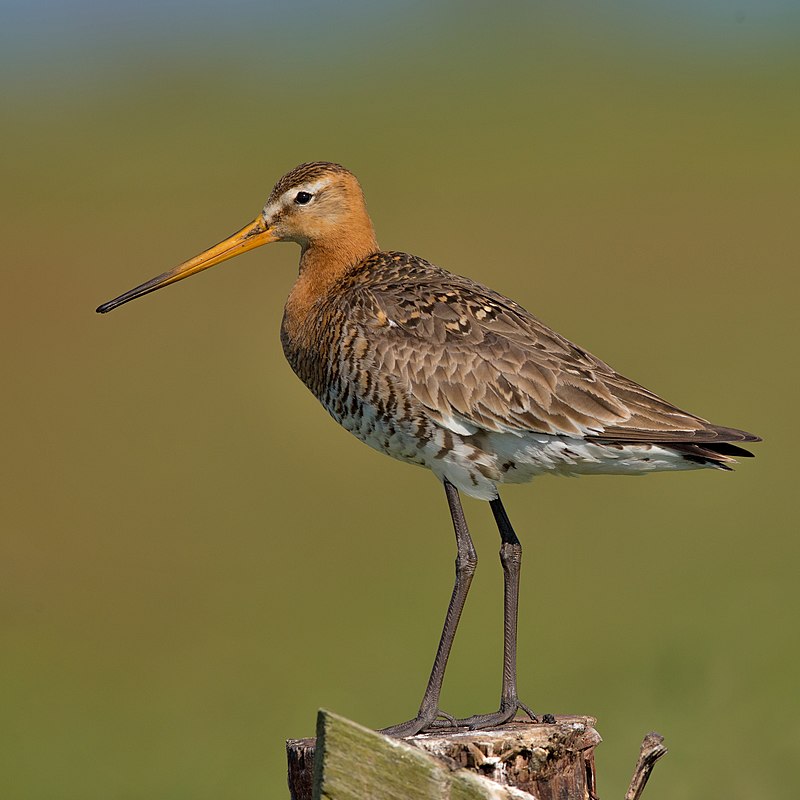
The Black-tailed Godwit is a species of large shorebird that was first described by Carl Linnaeus in 1758.
These beautiful birds have an orange head, neck and chest during breeding season while they turn to grey-brown coloration in winter.
They are easily identifiable due their black and white wingbar throughout the year. As for its habitat, these godwits breed mostly on Iceland but also across Europe, eastward through Asia Minor all the way to Mongolia; some even winter further south in Africa or India.
The Godwit has adapted well to human presence as it can be found close to wetlands near farms or villages where plenty of food is available from ploughed fields.
It’s really amazing how such a majestic bird with colorful plumage manages so successfully at this day and age.Scientific classification:
| Kingdom | Animalia |
| Phylum | Chordata |
| Class | Aves |
| Order | Charadriiformes |
| Family | Scolopacidae |
| Genus | Limosa |
| Species | L. limosa |
36. Red-Footed Falcon
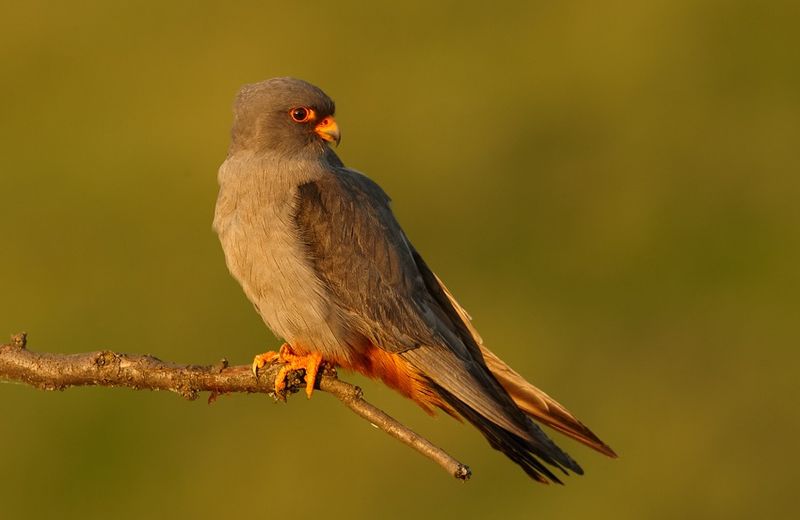
The Red-footed Falcon is a majestic bird of prey belonging to the Falconidae family. Found mainly in eastern Europe and Asia, numbers are unfortunately dwindling due to habitat loss and hunting.
This species migrates south for winter, with many birds making their way as far west as western Europe. In August 2004 one was even spotted in Britain; quite an impressive feat.
They have a striking plumage consisting of rich chestnut red legs contrasting against its grey wings and white underbelly – lending itself well to identification from afar.
The diet of this raptor mostly consists of small mammals such as mice or voles but it has also been known to feed on insects too.
A threatened species, conservation efforts must be made if we wish for generations after us to appreciate these beautiful falcons that soar across our skies.Scientific classification:
| Kingdom | Animalia |
| Phylum | Chordata |
| Class | Aves |
| Order | Falconiformes |
| Family | Falconidae |
| Genus | Falco |
| Species | F. vespertinus |
37. Grebes
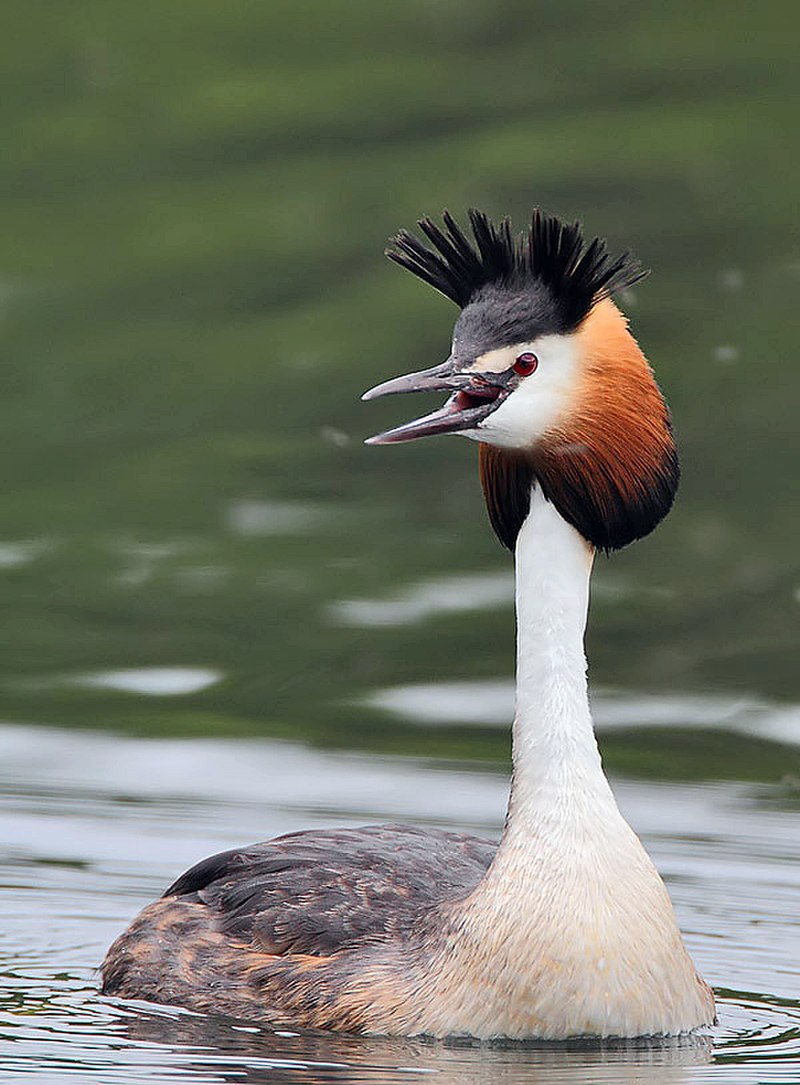
Grebes are a type of diving bird found in freshwater habitats around the world. They belong to the order Podicipediformes and have 22 species that exist across six genera.
Some species can also be found in marine environments during their migration or winter season, and some even live flightless lives on stable lakes.
Grebes vary greatly between regions; for example, they range from 4-32 inches long with anywhere from 8-30 ounces of weight depending on which species it is.
Their plumage may be black, browns/grays or whites but usually consist of bright colors such as yellows, blues and greens while underwater they use these feathers to help them streamline through the water quickly.Scientific classification:
| Kingdom | Animalia |
| Phylum | Chordata |
| Class | Aves |
| Clade | Neoaves |
| Clade | Mirandornithes |
| Order | Podicipediformes Fürbringer, 1888 |
| Family | Podicipedidae Bonaparte, 1831 |
38. Montagu’s Harrier
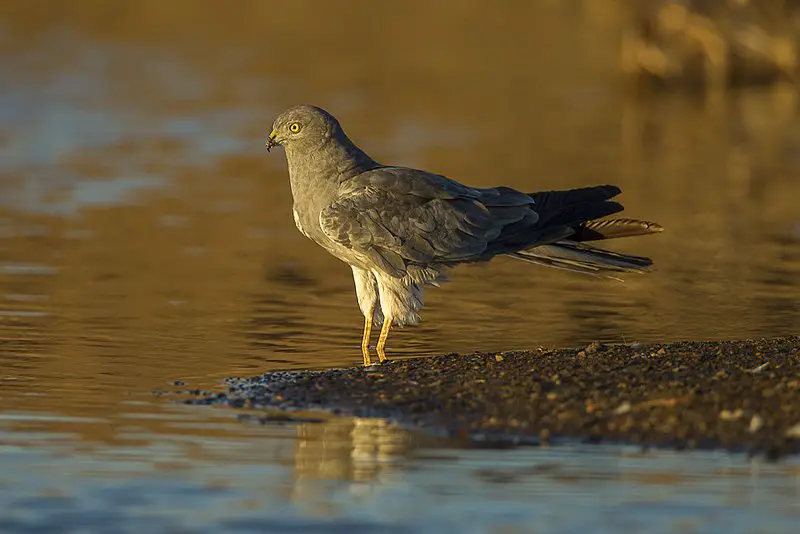
Montagu’s harrier is a migratory bird of prey belonging to the Harrier family. Named after British naturalist George Montagu, it was first formally described by Swedish naturalist Carl Linnaeus in 1758 under its binomial name Falco pygargus.
The genus Circus was introduced by French naturalis later on for this species. It has dark brown upper parts and white underside with yellow legs and bill.
During breeding season the male shows grey-blue back while female displays more streaked patterned plumage which helps them camouflage well into grasslands environment where they usually hunt rodents, reptiles and small birds as food source during migration period when they are not restricted to nesting areas only.
They are mostly found in Europe but also occasionally seen over North Africa due to their long distance travelling nature making them an interesting part of wildlife diversity around the world.Scientific classification:
| Kingdom | Animalia |
| Phylum | Chordata |
| Class | Aves |
| Order | Accipitriformes |
| Family | Accipitridae |
| Genus | Circus |
| Species | C. pygargus |
39. Oystercatchers
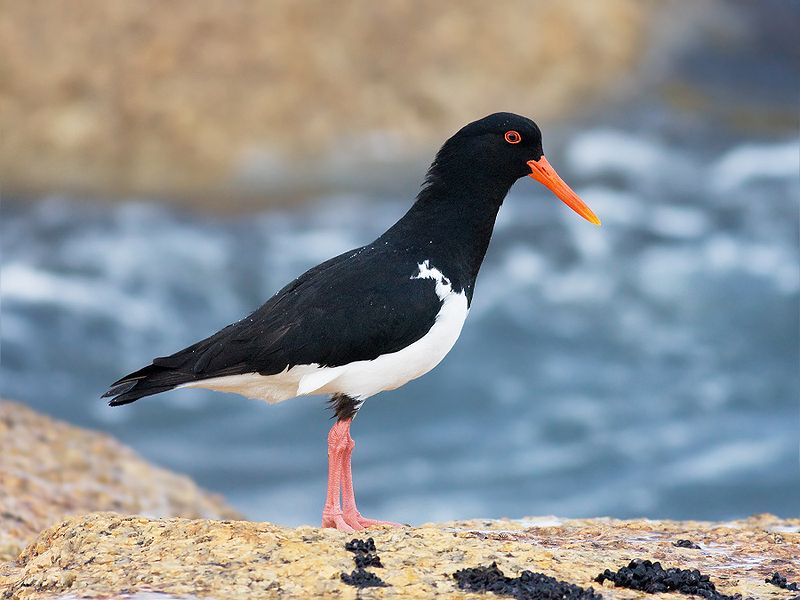
Oystercatchers are a family of waders forming the Haematopodidae, with one genus; Haematopus.
They live in coastal regions around the world excluding both polar and some tropical areas of Africa & South East Asia.
Eurasian, South Island & Magellanic oystercatcher species also breed far inland – breeding grounds being found much deeper than other members of the family.
They have long beaks used to feed on molluscs such as mussels, clams and oysters which they crack open using their strong bills.
Oystercatchers are usually quite vocal birds making various loud calls when disturbed or alarmed.
The males tend to display more brightly coloured plumage compared to females who share similar brown/black hues for camouflage purposes during nesting season.Scientific classification:
| Kingdom | Animalia |
| Phylum | Chordata |
| Class | Aves |
| Order | Charadriiformes |
| Suborder | Charadrii |
| Family | Haematopodidae Bonaparte, 1838 |
| Genus | Haematopus Linnaeus, 1758 |
Also Featured In: Birds You’ll Find in the Sea, Native Birds of Kazakhstan
40. European Roller

The European roller is a beautiful bird belonging to the Coracias family, and it’s the only one of its kind found in Europe.
It inhabits various habitats such as dry wooded savanna, bushy plains and other areas except for treeless ones.
During wintertime they usually nest in tree holes, while their range extends into Middle East, Central Asia and Maghreb regions.
They have vibrant blue feathers with black stripes along the neck area which makes them stand out from other birds easily.
Its diet consists mainly of insects like grasshoppers or beetles that are hunted by catching them mid-air during flight; this feature adds an extra charm to these magnificent creatures.Scientific classification:
| Kingdom | Animalia |
| Phylum | Chordata |
| Class | Aves |
| Order | Coraciiformes |
| Family | Coraciidae |
| Genus | Coracias |
| Species | C. garrulus |